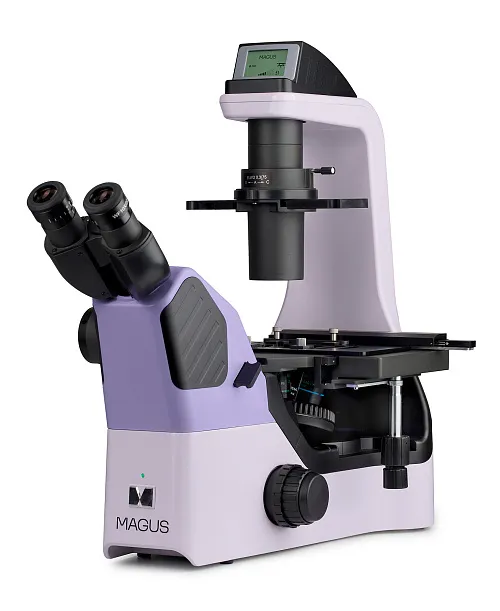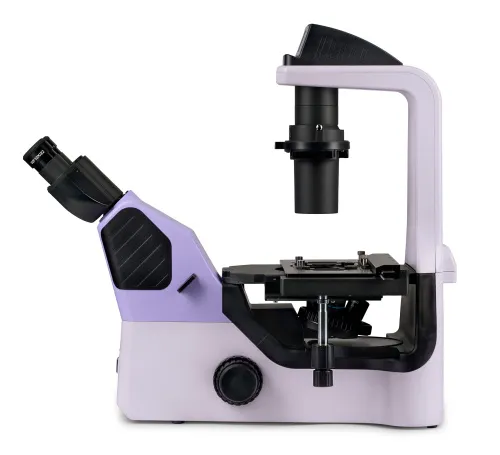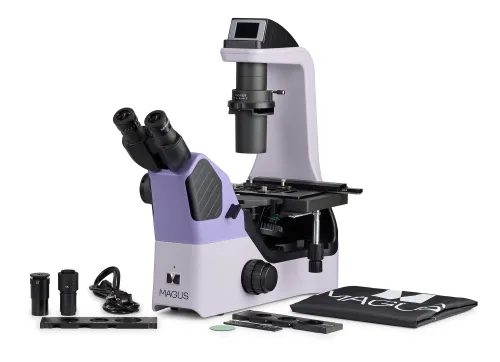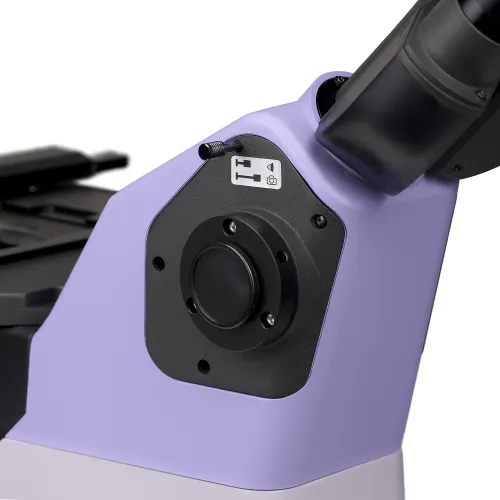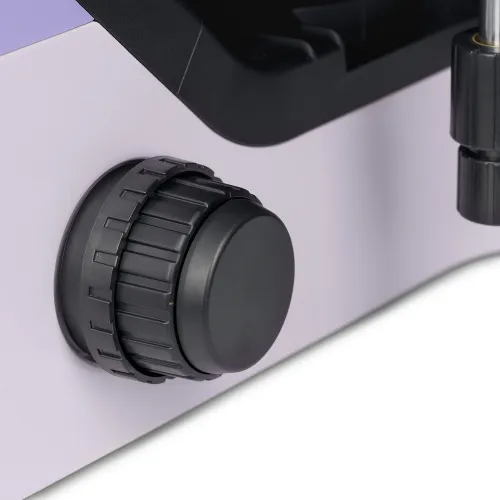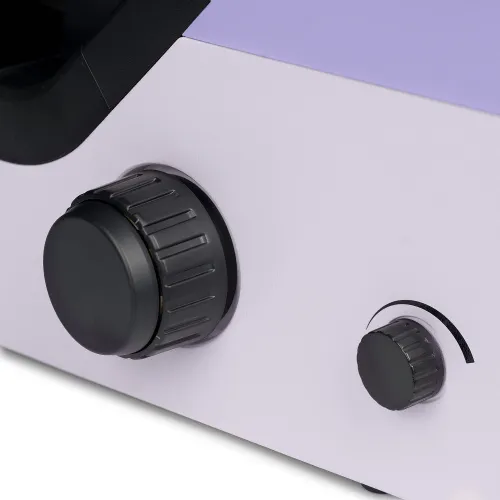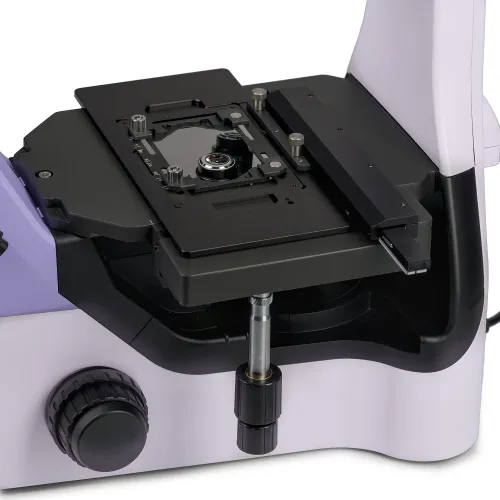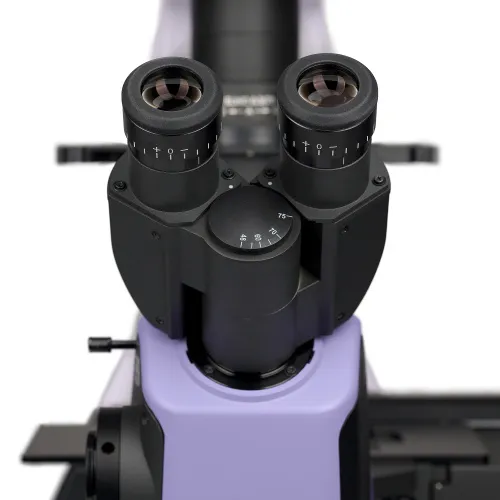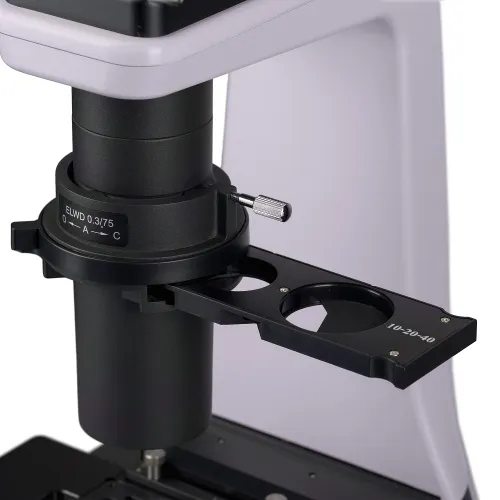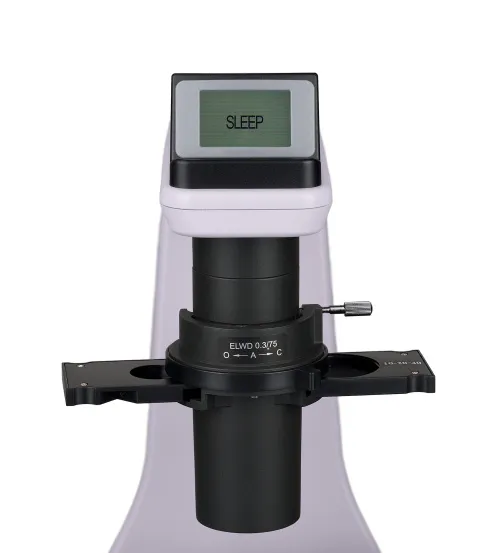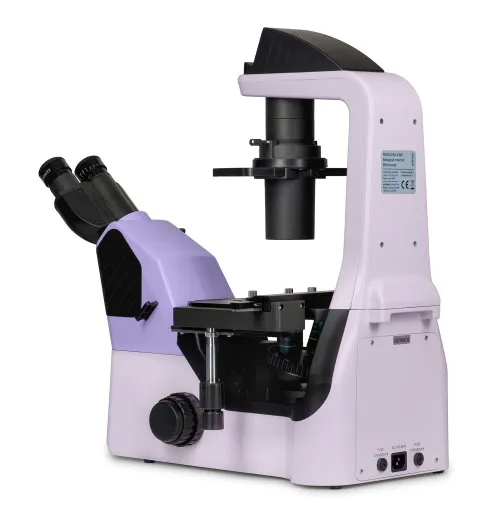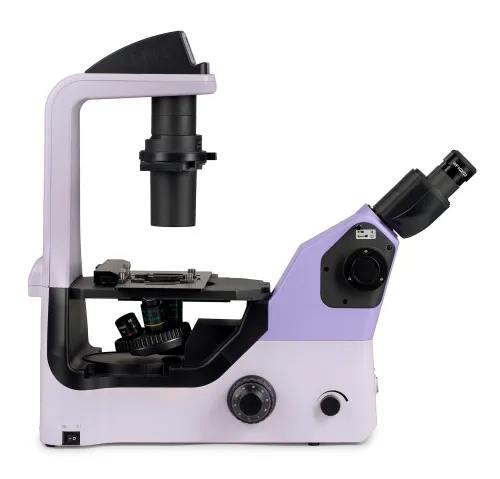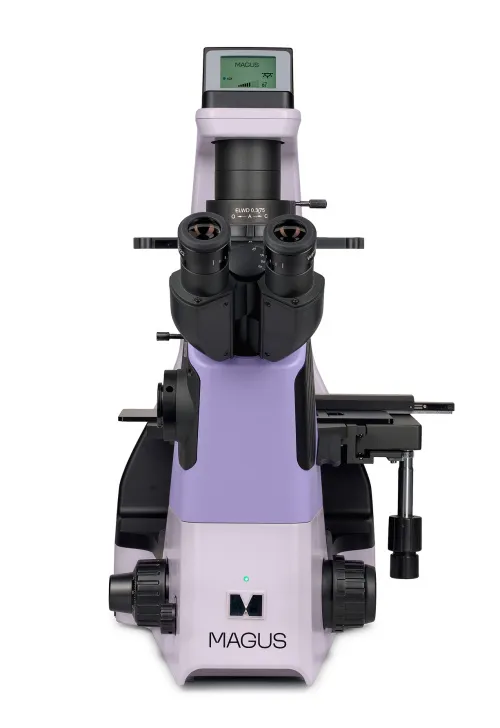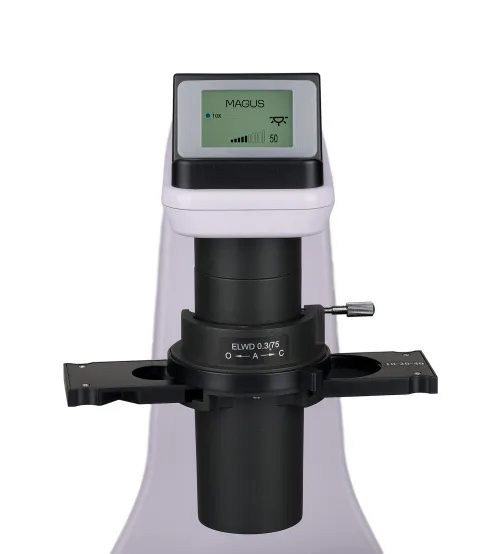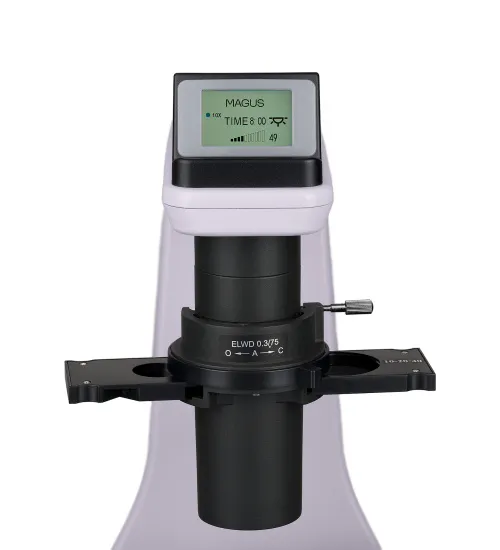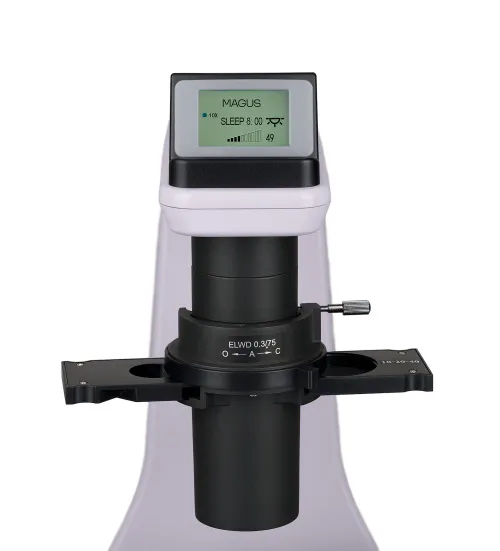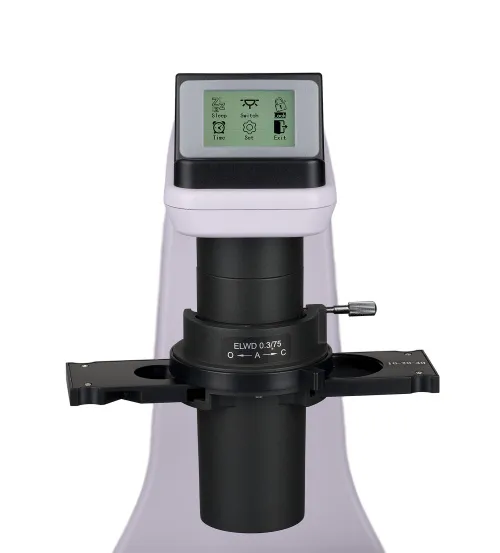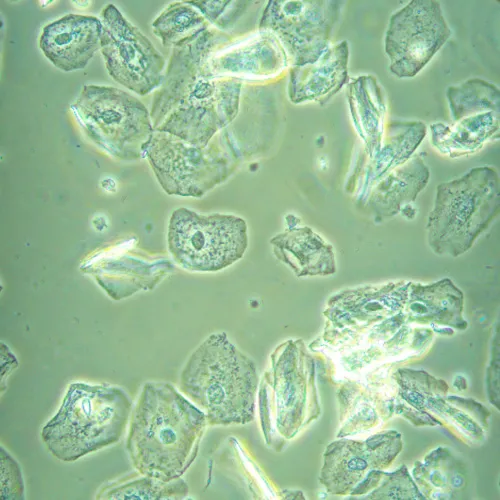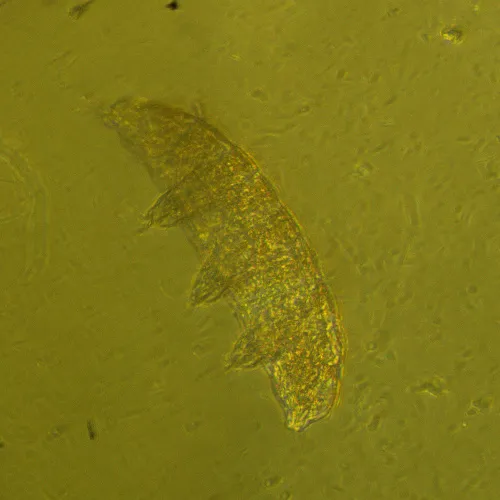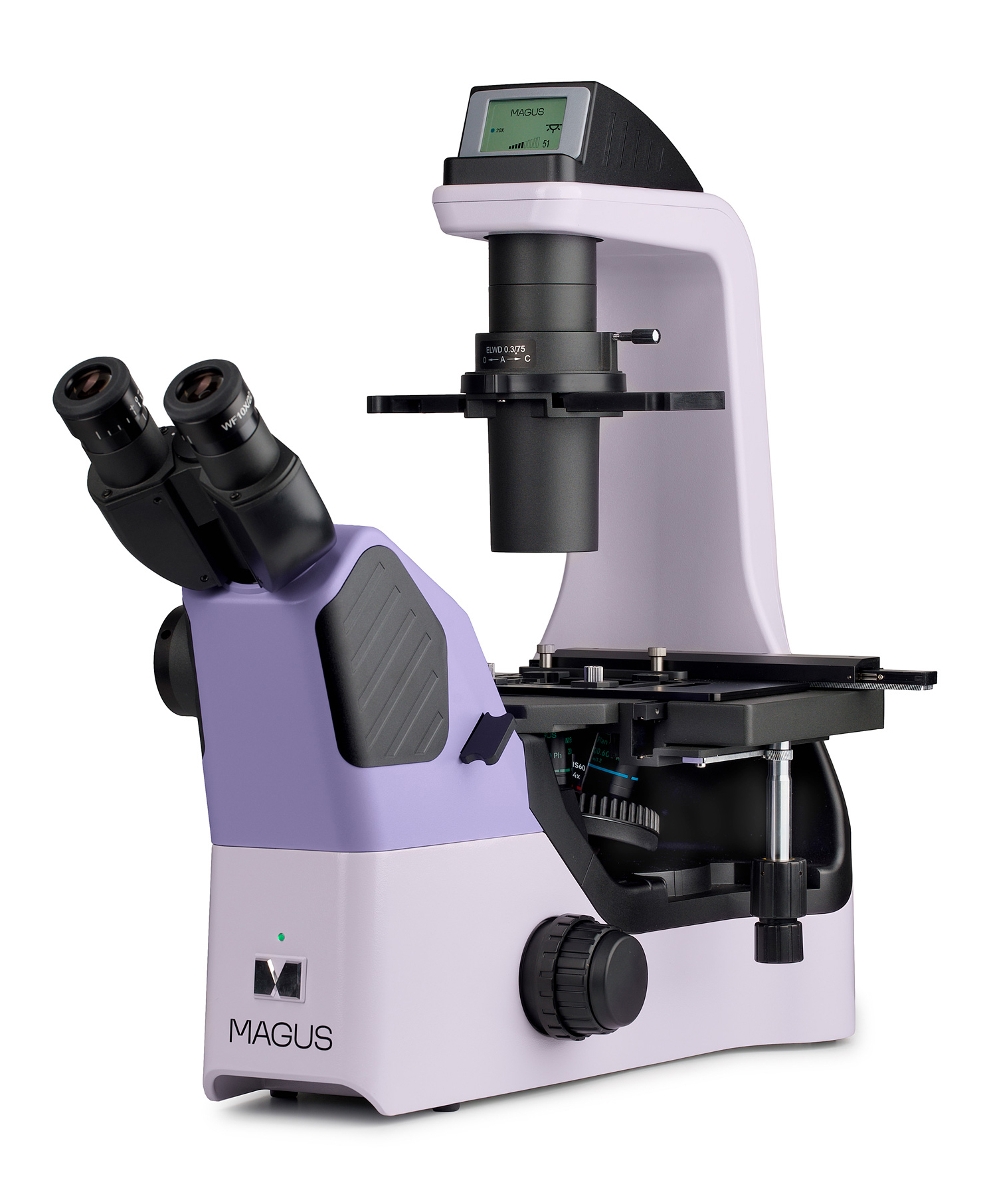MAGUS Bio V360 Biological Inverted Microscope
Magnification: 40–400x. Binocular microscope head with side camera port, plan achromatic objectives, 3W LED illuminator, condenser with phase slider, emboss contrast device, and intelligent lighting control system
| Product ID | 83483 |
| Brand | MAGUS |
| Warranty | 5 years |
| EAN | 5905555019499 |
| Package size (LxWxH) | 56x65x67 cm |
| Shipping Weight | 24.4 kg |
Research grade microscope.
It is designed for studying liquid precipitates, cell colonies, living cells, tissue cultures, and other stained and unstained specimens in lab glassware.
Its inverted design allows for the use of Petri dishes, multi-well plates, vials, roller bottles, and flasks up to 75mm with a bottom thickness of 1.2mm. The microscope uses special objectives for working with such glassware.
With the condenser removed, it is possible to observe cell cultures in Petri dishes or in cylindrical flasks up to 187mm.
Observations are made in transmitted light using the brightfield, phase contrast, and emboss contrast techniques. Optional components will allow for the use of the Hoffman modulation contrast techniques. The microscope is used for research in medicine, pharmacology, biology, and virology. The top configuration of the microscope is suitable for IVF.
Microscope head
Binocular head with infinity-corrected optics. The digital camera is installed in the side port on the microscope head. The beam splits 100/0 or 0/100. A slot with a plug is intended for installing the emboss contrast slider.
Revolving nosepiece
Coded revolving nosepiece for 5 objectives. An additional objective can also be installed in the free slot in order to achieve extra magnification.
Objectives
Infinity plan achromatic objectives with long working distance for dishes with a bottom thickness of 1.2mm. The parfocal distance is 60mm. The 4x objectives are used for the brightfield technique. The 10х, 20х, and 40х objectives are phase objectives that differ from the 4x objectives by having a phase ring in the plane of the exit pupil. These objectives are designed for phase contrast observations, but they are also suitable for the brightfield and emboss contrast techniques.
Maintaining comfortable brightness levels when switching magnifications
The objectives of different magnifications transmit light with different levels of intensity, and so each time you change objectives, the brightness of the light must be adjusted. In addition, brightness sharply increases when switching from a higher magnification objective to a lower magnification one. A sharp increase in brightness causes eye fatigue. MAGUS Bio V360 is equipped with intelligent brightness control. The microscope remembers the brightness for each objective that the user has selected and it automatically sets this brightness when turning the nosepiece. Intelligent control reduces the time required to adjust the brightness. MAGUS Bio V360 increases user comfort and saves time even when work requires frequent magnification changes.
Focusing mechanism
The coarse and fine focusing knobs are coaxial and located low. The researcher can place their hands on the table and take a comfortable position in front of the microscope.
The ring on the right side adjusts the tension of the coarse focusing travel. The user adjusts the comfortable tension for work.
Stage
The mechanical stage is fixed. A special mechanism is installed on the stage, which moves laboratory glassware in two mutually perpendicular directions. The smooth and subtle movement of the object provides accurate study: no part of the specimen will be overlooked.
The long stage control handle ensures user comfort while working: Your hand can rest on the table without any strain.
The microscope kit includes a universal dish holder.
Condenser
The condenser has 0.3 NA and a working distance of 75mm. A phase contrast slider or an emboss contrast slider with a sector diaphragm is installed in the condenser slot.
A phase contrast slider is a plate with three holes. One hole has a phase insert for 10x, 20x, and 40x objectives, while the other two are used for brightfield observations. The annular diaphragm of the slider is aligned with the phase ring of the objective using a centering telescope.
An emboss contrast slider with a sector diaphragm is also a plate with three holes. The emboss contrast microscopy is enabled by introducing the sector diaphragm into the optical path and setting the slider in the microscope head slot to the position that matches the objective being used. The green filter (ND6), when placed into the slot with the sector diaphragm, removes color halos at the edges of the observed structures. The slider’s free holes are designed for brightfield observations: one for a 4x objective and the second one for 10х, 20х, and 40х objectives.
Illumination
The 3W LED delivers bright specimen illumination that is sufficient for all of the microscope’s available techniques and objectives. The color temperature does not change when you adjust the brightness. The LED has a lifespan of 50,000 hours.
LCD status screen
The LCD screen on the base of the microscope displays the objective magnification, the brightness of the light source, and the operating mode (“sleep”, “eco”).
Using the screen and the relevant knobs, the microscope user adjusts the brightness, locks brightness adjustment, and sets the sleep mode and the auto-off timer.
Ergonomic design
Physical discomfort causes fatigue and reduces productivity. The ergonomic design of the microscope plays an important role in everyday scientific research.
MAGUS Bio V360 provides user comfort during work.
The microscope head is located at an ergonomic angle so that your back and neck do not get tired.
Thanks to the low and compact stage, it is convenient for the user to manipulate the sample and work with laboratory glassware.
The long handle of the movement mechanism makes it so that you do not need to raise your hand from the table to control the microscope, nor to change your comfortable position.
Focusing knobs are located at the bottom of the body. The user does not need to strain their hands. Thanks to the smooth movement of the mechanism, the user can effortlessly focus on the object.
Accessories
There is a line of accessories that are designed for this microscope.
The eyepieces extend the magnification range of the microscope. Additional eyepieces help you to use the full potential of an objective that is used more often.
The Hoffman modulation contrast device enhances the contrast techniques, allowing you to observe those objects that are invisible in the brightfield and enabling the real-time study of dynamic processes.A digital camera outputs the microscope image to a monitor, store files, and then software takes real-time measurements of specimens.
A calibration slide is used to measure objects, and it can be combined with the eyepiece with a scale or with the camera software.
Dish holders and stage inserts are used for the convenient installation of culture bottles of various types and sizes on the microscope.
Key features:
- Research of stained and unstained objects in laboratory glassware: Petri dishes, flasks, plates, work with glassware up to 187mm in height
- Microscopy techniques: brightfield, phase contrast, and emboss contrast; with optional accessories: Hoffman modulation contrast
- Coded revolving nosepiece: The brightness of the light source is set automatically depending on the selected objective
- Binocular head with side tube for mounting a digital camera; 100/0 or 0/100 beam splitting
- Transmitted light illuminator is energy-saving 3W LED with a lifetime of up to 50,000 hours
- Condenser with a slot for installing sliders; phase-contrast slider included, phase rings are centered
- Smart lighting control system: automatic brightness selection, dimming lock, timer auto-off, LCD operating status screen
- Stage with glassware movement along the X and Y axes, a universal dish holder included, a long stage control handle ensures user comfort while working
The kit includes:
- Stand with built-in power supply, transmitted light source, focusing mechanism, stage, condenser mount, and revolving nosepiece
- Condenser with a slider slot
- Binocular microscope head with side tube
- Infinity-corrected plan achromatic objective: 4x/0.10 WD 30mm, parfocal height 60mm
- Infinity-corrected plan achromatic objective: 10x/0.25 phase WD 10.2mm, parfocal height 60mm
- Infinity-corrected plan achromatic objective: 20x/0.40 phase WD 12mm, parfocal height 60mm
- Infinity-corrected plan achromatic objective: 40x/0.60 phase WD 2.2mm, parfocal height 60mm
- Eyepiece 10x/22mm with long eye relief and diopter adjustment (2 pcs.)
- Eyepiece eyecup (2 pcs.)
- Centering telescope
- Phase contrast slider with centering phase rings
- Emboss contrast device
- Green filter
- Universal dish holder
- C-mount camera adapter
- AC power cord
- Dust cover
- User manual and warranty card
Available on request:
- 15x/16mm eyepiece (2 pcs.)
- 20x/12mm eyepiece (2 pcs.)
- Device for working with the Hoffman modulation contrast method
- Digital camera
- Calibration slide
- Monitor
| Product ID | 83483 |
| Brand | MAGUS |
| Warranty | 5 years |
| EAN | 5905555019499 |
| Package size (LxWxH) | 56x65x67 cm |
| Shipping Weight | 24.4 kg |
| Type | biological, light/optical |
| Microscope head type | binocular |
| Head | Siedentopf, with a side tube, beam splitting 0/100, 100/0 |
| Head inclination angle | 45 ° |
| Magnification, x | 40 — 400 |
| Magnification, x (optional) | 40–600/800 |
| C-mount adapter magnification, x | 0.5, 1 |
| Eyepiece tube diameter, mm | 30 |
| Eyepieces | 10x/22mm, long eye relief (*optional: 15х/16mm, 20х/12mm) |
| Objectives | infinity plan achromatic objectives: 4x/0.10; 10x/0.25 phase; 20x/0.40 phase; 40x/0.60 phase; parfocal distance: 60mm |
| Revolving nosepiece | 5 objectives, coded |
| Working distance, mm | 30 (4x); 10.2 (10x); 12 (20x); 2.2 (40xs) |
| Interpupillary distance, mm | 48 — 75 |
| Stage, mm | 250x170 |
| Stage moving range, mm | 80/128 |
| Stage features | fixed, universal dish holder, with a mechanical device for moving the sample |
| Eyepiece diopter adjustment, diopters | ±5D on each eyepiece |
| Eyepiece diopter adjustment | ✓ |
| Condenser | NA 0.3, working distance: 75mm; with an adjustable aperture diaphragm and a slot for the emboss contrast or phase contrast slider |
| Diaphragm | adjustable aperture |
| Focus | coaxial, coarse (37.7mm/circle, with coarse focusing tension adjustment) and fine (0.002mm) |
| Illumination | LED |
| Brightness adjustment | ✓ |
| Power supply | 100–240V, 50/60Hz, AC network |
| Light source type | 3W LED |
| Operating temperature range, °C | 10...+35 |
| Additional | automatic brightness adjustment when switching objectives, eco mode, sleep mode, status display on LCD screen |
| Ability to connect additional equipment | device for working with the Hoffman modulation contrast method |
| User level | experienced users, professionals |
| Assembly and installation difficulty level | complicated |
| Application | laboratory/medical |
| Illumination location | upper (transmitted light) |
| Research method | bright field, phase-contrast microscopy, emboss contrast |
| Pouch/case/bag in set | dust cover |
We have gathered answers to the most frequently asked questions to help you sort things out
Find out why studying eyes under a microscope is entertaining; how insects’ and arachnids’ eyes differ and what the best way is to observe such an interesting specimen
Read this review to learn how to observe human hair, what different hair looks like under a microscope and what magnification is required for observations
Learn what a numerical aperture is and how to choose a suitable objective lens for your microscope here
Learn what a spider looks like under microscope, when the best time is to take photos of it, how to study it properly at magnification and more interesting facts about observing insects and arachnids
This review for beginner explorers of the micro world introduces you to the optical, illuminating and mechanical parts of a microscope and their functions
Short article about Paramecium caudatum - a microorganism that is interesting to observe through any microscope

